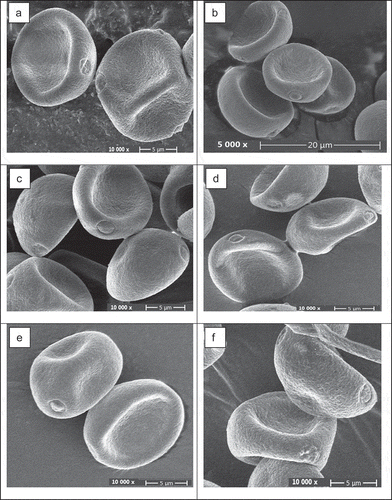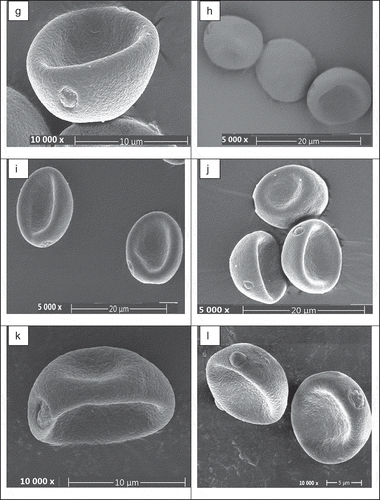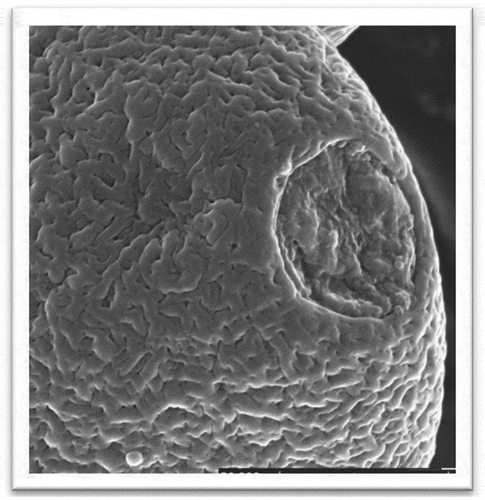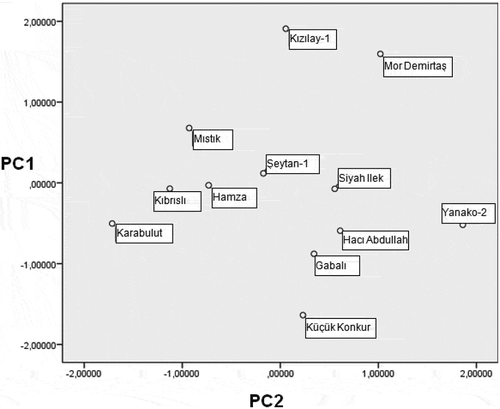ABSTRACT
Sarılop (Calimyrna) fig is an important dried variety known in the countries worldwide where fig cultivation is carried out caprification of this type of fig is required for its effect on yield and quality. For this purpose, fruit and pollen size, shape class, and surface sculpture are determined to identify male genotypes. In this study, these characteristics were examined for 12 genotypes were examined. Kızılay-1 variety was found to have larger fruits (33.5 g) and a larger ostiole diameter (6.0 mm) than other genotypes. SEM images of pollen grains of all samples were characterized by a suboblate shape except for Mıstık and Mor Demirtaş. In contrast, the Mor Demirtaş variety was longest in terms of pollen length (11.25 µm) and the Yanako-2 variety had the greatest pollen width (13.34 µm) and pori diameter (2.26 µm). All genotypes examined were determined to be 2-porate. These two components defined 72.502% of the genotypes. Genotypes were divided into groups according to clustering analysis.
Introduction
The fig (Ficus carica L.) is one of the oldest fruit species cultivated in the worldwide. It has been growing in Anatolia, Turkey, for thousands of years. Fig remains from the Neolithic Age have been found on archeological excavations. Principally, this is a typical fruit of the Mediterranean Basin. In Turkey, figs are grown in the Black Sea regions, Marmara, the Aegean and Mediterranean coasts, and south-eastern Anatolia (Özbek, Citation1978). However, Ficus carica is found in other countries such as California, Australia, and Argentina.
The fig belongs to the Ficus genus of the Moraceae family as part of the Urticales order. There are more than 2000 species in this genus. Most of them are used as ornamental plants (Özbek, Citation1978). Both female figs that can be edible fruit and male figs used in fertilization are included in Ficus carica species. Female and male figs are called Ficus carica domestica and Ficus carica caprificus, respectively.
Ficus carica produces syconia unlike other fruit species, and are dioecious. There are four types of fig flowers (male, neutral, female, and gal flowers). This species yields a crop three times per year. The male figs are referred to as profichi, mammoni, and mamme crops. Fertilization biology varies based on varieties. Accordingly, four different groups are seen: the Common fig, the Smyrna type, the San Pedro type, and the Male fig (Flaishman et al., Citation2008; Stover et al., Citation2007). To fruit set, some varieties, which is called parthenocarpy, do not require fertilization, whereas some varieties needs to be pollinated with pollen from the caprifig.
This process is called caprification and the profichi crop is used. In order to obtain optimum yield and quality, caprification is necessary in dried fig cultivars (Aksoy et al., Citation2003). The profichi produces much more pollen than the others. For quality profichi, it is desirable that the pollen germination rate and amount of pollen produced is high.
As a result, research into fruit and pollen characteristics of different male fig genotypes have been carried out and differences have been revealed (Akaroğlu et al., Citation2007; Çalışkan and Bayazit, Citation2012; Ilgın et al., Citation2007; Yaman and Çalışkan, Citation2016). It is important for pollen, which is extremely important for plant life, to be systematically identified. In addition, there have also been studies on the morphological characteristics of pollen using light and scanning electron microscopy (Teleb and Salah-El-din, Citation2014; Wang et al., Citation2014).
The best quality dry figs (Smyrna type) are grown in western Turkey due to favorable climatic conditions. Consequently, different male fig genotypes are used. This current study aimed to determine the pollen and fruit morphological characteristics of 12 male fig varieties commonly used in that area.
Materials and Methods
Pollen was gathered from the male fig genotypes, Gabalı, Hacı Abdullah, Hamza, Karabulut, Kıbrıslı, Kızılay-1, Küçük Konkur, Mıstık, Mor Demirtaş, Siyah İlek, Şeytan-1 and Yanako-2 syconia from Ficus carica caprifigus collected by the Republic of Turkey Ministry of Agriculture and Forestry Fig Research Institute. The fruit weight (g), fruit width (mm), fruit length (mm) and ostiole diameter (mm) of 30 samples were measured. Fig pollen was obtained from the profichi crop. For this purpose, ripe caprifigs were harvested in June. They were kept on papers in laboratory conditions. A few days later, the dried fruits were cut and the pollen removed. The pollen was stored until analysis (Storey, Citation1975). To examine the morphology of the pollen, scanning electron microscopy (SEM) was used. Dry pollen was sputter-coated (Leica model) with 10 µm of gold-palladium (Evrenosoglu and Mısırlı, Citation2009; Mert, Citation2010). Then, the samples were observed using a scanning electron microscope (Thermo Scientific Apreo S model) and the whole grain was photographed at a 10000 x magnification. The pollen length (polar axis), width (equatorial axis), length/width ratio, and pore diameter were measured for 20 pollen grains of each genotypes. The pollen shape was classified by considering the length/width ratio (Erdtman, Citation1952). The types of aperture found in the pollen have been described according to Wang et al. (Citation2014).
The SPSS 20 statistical software program was used to apply analysis of variance to the data obtained. The mean, minimum, maximum, and standard deviation values of the properties were determined. The relationship between these values was revealed by conducting Pearson’s correlation analysis. Furthermore, principal component analysis (PCA) and clustering analysis (CA) were also performed and presented via dendrogram.
Results
The variation in the minimum, maximum, mean values and standard deviations of the pollen parameters is shown in . Depending on the male fig genotype there was a statistical difference in terms of pollen morphology. Accordingly, minimum pollen length was found to be 9.60 µm for Karabulut, while the maximum length was found to be 11.25 µm for Mor Demirtaş, with Yanako-2 in second place with 11.17 µm. Gabalı and Hacı Abdullah were in the same statistical group. All genotypes, except for Mıstık, had similar values. As a result, differences in the Karabulut genotype (9.02 to 10.19 µm) caused a higher standard deviation value (1.15). The lowest and highest pollen width values were determined in the Mıstık (11.83 µm) and Yanako-2 (13.34 µm) genotypes, respectively. According to the data, the Yanako-2 genotype was noticeable for its pollen size. Gabalı, Hacı Abdullah, Küçük Konkur, Mor Demirtaş, Siyah İlek (ab); Hamza, Karabulut, Şeytan-1 (bc); Mıstık, Kıbrıslı (c) appeared to be in the same statistical group. The highest value in terms of the length/width ratio was found in the Mıstık genotype at 0.90. This was followed by Mor Demirtaş at 0.88. Conversely, the lowest value was determined in the Karabulut genotype with 0.78. Other genotypes were among these values. Considering pori diameter, Yanako-2 (2.26 µm) was located in the first group, while the Mıstık (1.85 µm) was in the last group. The same statistical group included other genotypes. Similar to other features, Yanako-2 ranked first in terms of pore diameter.
Table 1. Pollen properties of Ficus carica male genotypes
Determining the shape of pollen depended on the P/E ratio (the ratio between polar and equatorial diameter). The male fig genotypes were found to be suboblate (0.75 to 0.88), but Mıstık and Mor Demirtaş were found to be oblate spheroidal (0.88 to 1.00) (Erdtman, Citation1952). When the SEM images of pollen were evaluated, there were circular apertures on the surface of pollen grains which are called pores ( and ). These are known as porate (a pollen grain which has one or more pores). All genotypes examined were found to be 2-porate.
Figure 1. Scanning electron microscope image of pollen. Gabalı (a), Hacı Abdullah (b), Hamza (c), Karabulut (d), Kıbrıslı (e), Kızılay-1 (f), Küçük Konkur

Figure 1. Küçük Konkur (g), Mıstık (h), Mor Demirtaş (i), Siyah İlek (j), Şeytan-1 (k), Yanako-2 (l)

The characteristics of the fruit examined were statistically different according to the male fig genotypes (). Kızılay-1 (33.5 g) had the biggest fruits, whereas, the smallest fruits were found in the Küçük Konkur genotype (18.2 g). In addition, the highest and lowest standard deviations were seen in the Şeytan-1 and Kıbrıslı genotypes, respectively. Fruit width ranged from 38.0 mm (Küçük Konkur) to 48.5 mm (Mor Demirtaş). In addition, fruit length variation varied from 40.9 mm (Küçük Konkur) to 53.3 mm (Hamza). The highest and lowest values in terms of fruit weight and fruit width were measured in the Kızılay-1 and Küçük Konkur genotypes, respectively. In addition, to Kızılay-1 (6.0 mm) genotype attracted attention because of its large ostiole diameter. The smallest ostiole diameter was found in the Şeytan-1 (3.0 mm).
Table 2. Fruit properties of Ficus carica male genotypes
The correlation coefficients analysis was performed for the characteristics examined in the male fig genotypes (). According to the analysis results, the highest positive and strongest correlation was observed between fruit weight and width (r = 0.953; p < .01). Similarly, fruit weight was correlated with fruit length and ostiole diameter, and there was a correlation between fruit width and ostiole diameter. Also, as pollen width increased, pollen length (r = 0.654) increased. So there was a positive correlation between these properties.
Table 3. Pearson correlation coefficients among traits in male fig genotypes
Principal component analysis was used to examine the fig varieties, and two principal components defined 72.502% of them (). Consequently, PC1 included fruit weight, fruit width, ostiole diameter and fruit length constituted 43.848% of the total variance. PC2 included pollen length, pollen width, and pore diameter accounting for 28.654% of the total variance.
Table 4. Component loading in principle component analysis (PCA)
As a result of clustering analysis performed on the male fig genotypes, two groups were obtained and shown as dendrograms in . According to this, the first group consisted of Siyah İlek, Şeytan-1, Kıbrıslı, Mıstık, Hamza, Kızılay-1 and Mor Demirtaş, while the second group included Gabalı, Hacı Abdullah, Yanako-2 Karabulut, and Küçük Konkur. Clustering analysis was also used to show the degree of similarity between fig varieties (), and the relationships between the male fig genotypes, which, as a result, categorized the varieties under the two groups.
Discussion
There have been studies on pollen morphology for different Ficus species. Teleb and Salah-El-din (Citation2014) reported that pollen was small sized (less than 20 μm) in all the different investigated Ficus species. This results of this present study showed that pollen sizes were similar to those obtained by that research. Contrary to this study, 15 different Ficus species; genotypes were reported to have circular or elliptical pollen shapes. All genotypes examined in this present study were found to be 2-porate and this finding was supported by Teleb and Salah-El-din (Citation2014) with species such as F. afzelii, F. cunninghamii, F. platypoda, and F. religiosa. In another work by Wang et al. (Citation2014), pollen samples of 25 Ficus species were collected from living trees in China. As a result of the examination of their pollen morphology using SEM, the variation range was determined to be 4.13 9.02 μm for the polar axis, 7.29 to 14.20 μm for the equatorial axis, and 0.45 to 0.96 for the P/E value. In addition, three pollen shapes (elliptical, rectangular and circular) were found in the samples examined. The finding differed from this present study because of the different Ficus species. Confirming our data, Chantarasuwan et al. (Citation2014) said that the pores were circular shaped in all material studied belonging to Ficus section Urostigma. Also, in a study of exine ornamentation, the lumina exhibited anastomosis, thus the pollen surface sculpture was observed to be rugulate (Wang et al., Citation2014). Various studies on pollen morphology and statistical analysis have been conducted in many fruit species such as walnut (Milatović et al., Citation2020), sour cherry (Nikolić et al., Citation2020), Rosa species (Singh et al., Citation2020) and Apple (Dar et al., Citation2020); however, similar studies have not been found on Ficus carica caprificus.
Evaluations of fruit characteristics, fruit weight, and sizes of male fig varieties were determined at the same location by Akaroğlu et al. (Citation2007). Additionally, Yaman and Çalışkan (Citation2016) stated that the average fruit weight was found to be 27.32 g, the fruit width was 44.15 mm, the fruit length was 55.97 mm and the ostiole width was 3.07 mm in 12 male fig genotypes. In Iran, numerous morphological features of 53 local male fig accessions were identified. There, fruit length varied from 25.30 to 55.60 mm, fruit width ranged from 18.60 to 34.70 mm, fruit weight varied from 2.00 to 38.12 g and the ostiole width ranged from 5.80 to 15.00 mm (Khadivi-Khub and Anjam, Citation2014). As expected, differences arose from different genotypes. In the study by Mirheidari et al. (Citation2020), 68 caprifig accessions sampled from the wild in Iran (Isfahan, Gilan, and Mazandaran) were evaluated. Accordingly, fruit fresh weight ranged from 0.12 to 8.25 g in caprifigs. The average fruit length, width, weight, and ostiole diameter were determined to be 19.79 mm, 15.31 mm, 1.46 g and 3.64 mm, respectively. Furthermore, Essid et al. (Citation2017) found the average fruit weight of 15 caprifigs to be 14.26 g. This value was lower than in this present study. In Turkey, the morphological characteristics of six standard cultivars and 90 caprifig accessions grown in the eastern Mediterranean region were investigated by Caliskan et al. (Citation2017). The average fruit weight, fruit width, fruit length, and ostiole width values measured in the genotypes investigated in this current study were 22.9 g, 41.5 mm, 48.5 mm, and 1.8 mm, respectively, and were in agreement with those found by Caliskan et al. (Citation2017). In the fig, one of the oldest fruit species in the world, studies have been conducted to determine morphological and pomological characteristics of edible genotypes as well as male genotypes (Khadivi et al., Citation2018; Mirheidari et al., Citation2020).
In the statistical analysis of data, similar to our evaluation, the similarity and differences of 17 Ficus species were evaluated by clustering analysis in Egypt. Accordingly, the dendrogram was divided into two main groups (Teleb and Salah-El-din, Citation2014). Consistent with our study, clustering analysis was carried out for the Prunus species (Geraci et al., Citation2012).
Mirheidari et al. (Citation2020) used PCA to study of caprifigs and observed 14 components that explained 80.48% of the total variance. Similarly, Khadivi-Khub and Anjam (Citation2014) stated 10 components that explained 76.09% of the total variance. By contrast, in Turkey, Caliskan et al. (Citation2017) stated that PCA showed the first 14 components contributed to 75.38% of the total variance for selected and standard caprifigs genotypes. In our study, PC1 was mainly correlated with fruit weight, width, ostiole diameter, and fruit length, constituting for 43.85% of the total variance and this agreed with Mirheidari et al. (Citation2020) in terms of ostiole diameter. The same researchers reported that the genotypes were formed from two principal components. These analyzes were carried out to determine the genotypic distribution of edible figs (Giraldo et al., Citation2010; Khadivi et al., Citation2018; Mirheidari et al., Citation2020; Podgornik et al., Citation2010).
For the correlation analysis, according to Essid et al. (Citation2017), the fruit weight exhibited a strong correlation with fruit diameter (r = 0.86). Also, a positive correlation was observed between fruit length and weight (r = 0.54). The correlation coefficients of the data in question were higher in our study. Pearson correlation coefficient analysis revealed significant correlations between fruit weight, fruit length, and fruit width. This finding has also been expressed by different researchers (Caliskan et al., Citation2017; Khadivi-Khub and Anjam, Citation2014).
Conclusions
As a result of this study, these morphological properties of pollen can be used for identification of varieties. Mıstık and Mor Demirtaş male fig genotypes were distinguished from other genotypes in terms of pollen shape. Furthermore, Mıstık and Yanako-2 had the narrowest and widest pori, respectively. The Yanako-2 genotype attracted attention in terms of pollen size a feature that also appeared in the dendrogram and where Kızılay-1 was found to have larger fruits and ostiole diameter than the other genotypes. Identification of genetic material is of great importance in terms of caprification and breeding.
Literature Cited
- Akaroğlu, N., U. Aksoy, G. Günver Dalkılıç, B. Şahin, and N. Şahin. 2007. Aydın ilinde bazı erkek incir çeşitlerinin fenolojik ve pomolojik özelliklerin belirlenmesi üzerinde araştırmalar. Türkiye V. Ulusal Bahçe Bitkileri Kongresi, 1:531–535. Turkish
- Aksoy, U., B. Balci, H.Z. Can, and S. Hepaksoy. 2003. Some significant results of the research-work in Turkey on Fig. Acta Hort. 605:173–181. doi: 10.17660/ActaHortic.2003.605.26.
- Çalışkan, O., and S. Bayazit. 2012. İncir yetiştiriciliğinde ilekleme ve önemi. MKU Ziraat Fakültesi Dergisi 17(1):47–61.Turkish.
- Caliskan, O., S. Bayazit, M. Ilgin, and N. Karatas. 2017. Morphological diversity of caprifig (Ficus carica var. caprificus) accessions in the eastern Mediterranean region of Turkey: Potential utility for caprification. Sci. Hortic. 222:46–56. doi: 10.1016/j.scienta.2017.05.008.
- Chantarasuwan, B., R. Ham, B. Heuven, and P.C. Welzen. 2014. Pollen morphology of Ficus subsection Urostigma (Moraceae) Thai For. Bull. (BOT.) 42:52–60.
- Dar, J.A., A.A. Wani, and M.K. Dhar. 2020. Preliminary pollen analysis of some apple cultivars in Kashmir: towards understanding the apple pollen morphology. Proc. Natl. Acad. Sci., India, Sect. B Biol. Sci. 90(2):431–438. doi: 10.1007/s40011-019-01117-6.
- Erdtman, G. 1952. Pollen morphology and plant taxonomy. Angiosperms. Almqvist and Wiksell, Stockholm.
- Essid, A., F. Aljane, and A. Ferchichi. 2017. Morphological characterization and pollen evaluation of some Tunisian ex situ planted caprifig (Ficus carica L.) ecotypes. South Afr. J. Bot. 111:134–143. doi: 10.1016/j.sajb.2017.03.001.
- Evrenosoglu, Y., and A. Mısırlı. 2009. Investigations on the pollen morphology of some fruit species. Turk. J. Agr. For. 33:181–190. doi: 10.3906/tar-0801-47.
- Flaishman, M.A., V. Rodov, and E. Stover. 2008. The fig: Botany, horticulture, and breeding. Hortic. Rev. (Am. Soc. Hortic. Sci.) 34:113–197.
- Geraci, A., V. Polizzano, P. Marino, and R. Schicchi. 2012. Investigation on the pollen morphology of traditional cultivars of Prunus species in Sicily. Acta Societatis Botanicorum Poloniae, 81(3) 175–184.
- Giraldo, E., M. Lopez Corrales, and J.I. Hormaza. 2010. Selection of the most discriminating morphological qualitative variables for characterization of fig germplasm. J. Am. Soc. Hortic. Sci. 135: 240–249. Hammer, Ø, Harper, D.A.T., Ryan. doi:10.21273/JASHS.135.3.240.
- Ilgın, M., F. Ergenoğlu, and S. Çağlar. 2007. Viability, germination and amount of pollen in selected caprifig types. Pak. J. Bot. 39(1):9–14.
- Khadivi, A., R. Anjam, and K. Anjam. 2018. Morphological and pomological characterization of edible fig (Ficus carica L.) to select the superior trees. Sci. Hortic. 238:66–74. doi: 10.1016/j.scienta.2018.04.031.
- Khadivi-Khub, A., and K. Anjam. 2014. Morphological characterization of Prunus scoparia using multivariate analysis. Plant Syst. Evol. 300:1361–1372. doi: 10.1007/s00606-013-0967-7.
- Mert, M. 2010. Anther and pollen morphology and anatomy in walnut (Juglans regia L.). Hortscience 45(5):757–760. doi: 10.21273/HORTSCI.45.5.757.
- Milatović, D., D. Nikolić, S. Janković, D. Janković, and J. Stanković. 2020. Morphological characteristics of male reproductive organs in some walnut (Juglans regia L.) genotypes. Sci. Hortic. 272:109587. doi: 10.1016/j.scienta.2020.109587.
- Mirheidari, F., A. Khadivi, Y. Moradi, and S. Paryan. 2020. Phenotypic variability of naturally grown edible fig (Ficus carica L.) and caprifig (Ficus carica var. caprificus Risso) accessions. Sci. Hortic. 267:1–13. doi: 10.1016/j.scienta.2020.109320.
- Nikolić, D., D. Milatović, A. Radović, and J. Trajković. 2020. Distinguishing Oblačinska sour cherry clones (Prunus Cerasus L.) by pollen morphology. GENETIKA 52(No1):187–198. doi: 10.2298/GENSR2001187N.
- Özbek, S. 1978. İncir. Özel meyvecilik. ÇÜZF yayınları. 128. Ders kitabı:11. Turkish: Cukurova University Faculty of Agriculture Press.
- Podgornik, M., I. Vuk, I. Vrhovnik, and D.B. Mavsar. 2010. A survey and morphological evaluation of fig (Ficus carica L.) genetic resources from Slovenia. Sci. Hortic. 125:380–389. doi: 10.1016/j.scienta.2010.04.030.
- Singh, K., Y. Pal Sharma, P.R. Sharma, and S. Gairola. 2020. Pollen morphology and variability of the Rosa L. species of Western Himalaya in India. Genet. Res. Crop Evol. doi: 10.1007/s10722-020-00967-8.
- Storey, W.B. 1975. Figs, p. 568–589. In: J. Janick and J.N. Moore eds.. Advances in fruit breeding. Purdue Univ. Press, West Lafayette.
- Stover, E., M. Aradhya, L. Ferguson, and C.H. Crisosto. 2007. The Fig: Overview of an ancient fruit. Hort Sci. 42(5):1083–1087. doi: 10.21273/HORTSCI.42.5.1083.
- Teleb, S.S., and R.M. Salah-El-din. 2014. Pollen morphology of some species of genus Ficus L. (Moraceae) from Egypt. Egypt. J. Bot. 54(1):87–102.
- Wang, G., J. Chen, Z.-B. Li, F.-P. Zhang, and D.-R. Yang. 2014. Has pollination mode shaped the evolution of Ficus pollen? PLoS ONE 9(1):e86231. doi: 10.1371/journal.pone.0086231.
- Yaman, S., and O. Çalışkan. 2016. Hatay’dan seçilmiş bazı erkek incir genotiplerinin (Ficus carica var. caprificus) tozlayıcı özellikleri. Anadolu. J. Agr. Sci. 31:315–320. Turkish.



